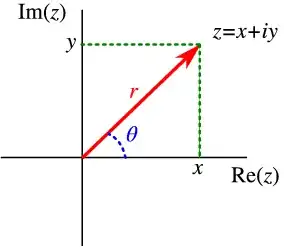I wanted to spell out my objection to the proof in a bit more detail.
For concreteness, when I'm thinking about a point in $\mathbb{R}^2$, I'll write it as $(x,y)$ as is customary. And to be clear, I'm thinking of $\mathbb{R}^2$ with its usual Euclidean vector space structure where we can measure lengths and angles as usual. I'm also viewing the distance function not as a formula, but as an input-output procedure. That is, I'm viewing it like a computer program where I type in $d((3,0), (0,4))$ and it spits out $5$. I don't get to see the inner workings of how it computes the answer.
On the other hand, we have this other algebraic structure $\mathbb{C}$. In the OPs proof, he/she attempts to prove something about $\mathbb{R}^2$ by proving something in $\mathbb{C}$ and then relating the two. To be clear, I'm thinking of $\mathbb{C}$ purely algebraically - there is no notion of distance or angles (yet).
It seems reasonable to assume that we want the identification of $\mathbb{C}$ with $\mathbb{R}^2$ to preserve some structure. Since both $\mathbb{R}^2$ and $\mathbb{C}$ are real $2$-dimensional vector spaces, it's reasonable to ask that any identification preserve this structure. Since $\{1,i\}$ forms a basis of $\mathbb{C}$ as a $\mathbb{R}$-vector space, the identification is determined once we identify $1$ and $i$ with points in $\mathbb{R}^2$.
Of course, the customary way is to identify $1$ with $(1,0)$ and $i$ with $(0,1)$. But there is nothing which forces us to adopt this.
Let's see what happens if we identify $1$ with $(1,0)$ and $i$ with $(1,1)$. Then a calculation reveals that that point $a+bi$ is identified with the ordered pair $(a+b,b)$. Going backwards, a point $(x,y)$ is identified with the complex number $(x-y)+yi$. Given $a\in\mathbb{C}$, I'll use $\vec{a}$ to denote its identified point in $\mathbb{R}^2$.
Notice that for the complex number $i$, if we write it in polar form as $1e^{i\pi/2}$, the number $1$ is not the length of $\vec{i}$. Indeed, $\vec{i} = (1,1)$ which has strictly longer length.
The obvious resolution is that whatever we identify $i$ with should have length $1$. So, instead of identifying $i$ with $(1,1)$, let's identify it with $\frac{1}{\sqrt{2}}(1,1)$. Then one can easily verify that $\vec{i}$ has length $1$.
Now, let's try to run the OP's proof in this modified setting.
Given a right triangle with legs of side lengths $4$ and $3$, we identify this (using my strange identification!) with the complex number $(4-3) + 3i = 1 + 3i$. Converting this to polar $1+3i = ce^{i\theta}$ and using the OPs line of computation, we conclude that $c = \sqrt{1^2 + 3^2} = \sqrt{10}$. This is true, but shows that the $c$ in the polar form is not the $c$ from the Pythagorean theorem.
The point is that we need something which tells us the $c$ in the polar form and the $c$ in the Pythagorean theorem are the same $c$.
Here is the something:
Fact: If we use the usual identification with $1 \mapsto (1,0)$ and $i\mapsto (0,1)$, then the two $c$s are the same.
So, if you know the Fact is true, then the OPs proof works to establish the Pythagorean theorem. Unfortunately, I do not know of a proof of the Fact which doesn't already use the Pythagorean theorem.
